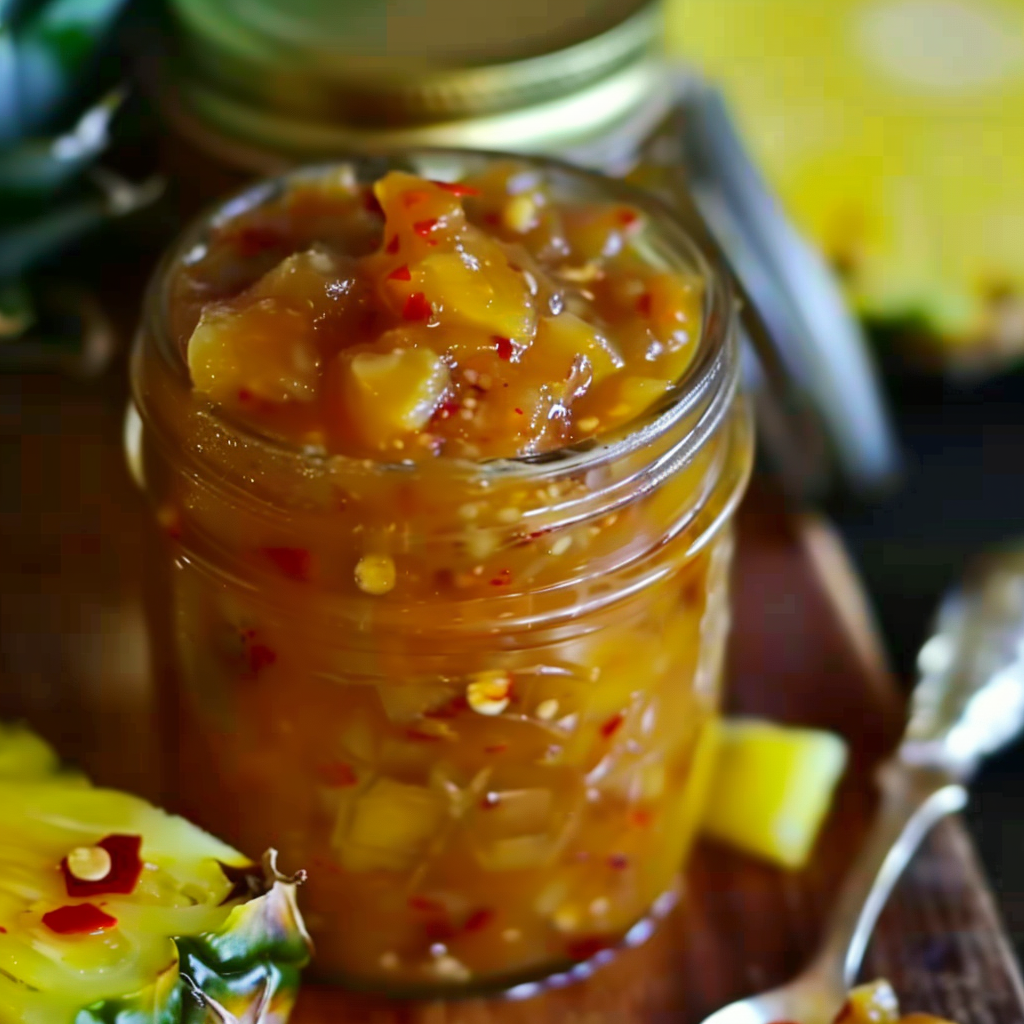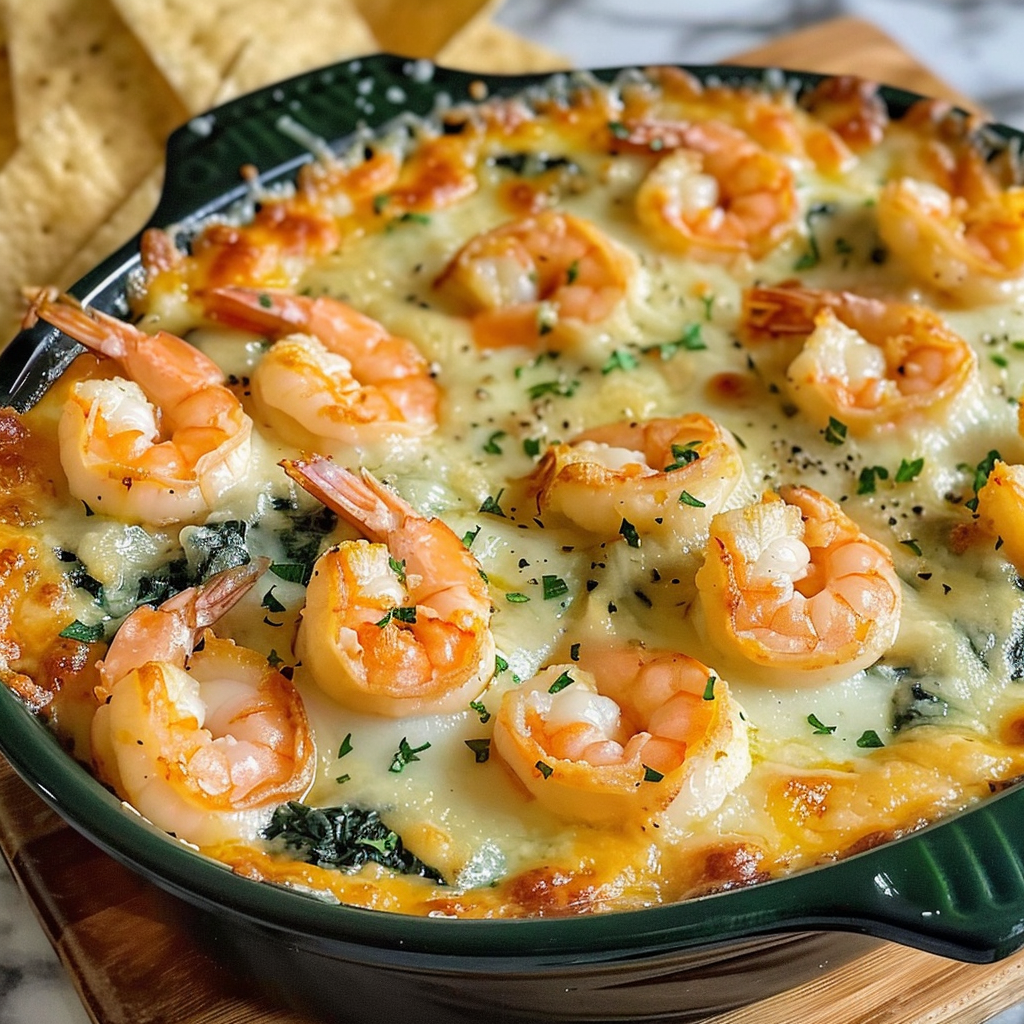1.Sweet Chili Pineapple Sauce
If you’re looking for a sauce that balances sweet, spicy, and tangy in a single spoonful, then Sweet Chili Pineapple Sauce should be at the top of your must-make list. This homemade condiment is a vibrant, flavor-packed addition to any kitchen, transforming everything from grilled meats to fresh vegetables with its tropical punch and spicy kick.
Unlike typical sauces, this pineapple chili glaze combines the fruity brightness of pineapple with the gentle heat of sweet chili sauce, creating a multi-purpose condiment perfect for dipping, drizzling, or glazing. Whether you’re throwing together an impromptu snack board or preparing a full dinner spread, this sauce adds a layer of complexity that’s both refreshing and bold.
The key ingredient—pineapple—offers natural sweetness and acidity. You can use either canned or fresh pineapple, though each has a unique impact on texture and flavor. According to Wikipedia, pineapple contains bromelain, an enzyme that tenderizes meat, making this sauce an excellent marinade as well. Meanwhile, the base of sweet chili sauce (see Sweet chili sauce on Wikipedia) adds gentle heat and umami richness, especially when paired with soy sauce and garlic powder. If you’re aiming for flavor harmony in one bottle, this is it.
On Pinterest, recipes like those found in Pineapple Sauce Recipes and Asian-Inspired Glazes show how versatile this kind of sauce can be. Whether used for tropical BBQ chicken or as a pineapple dipping sauce for crispy tofu, this homemade version surpasses store-bought alternatives in freshness, depth, and adaptability.
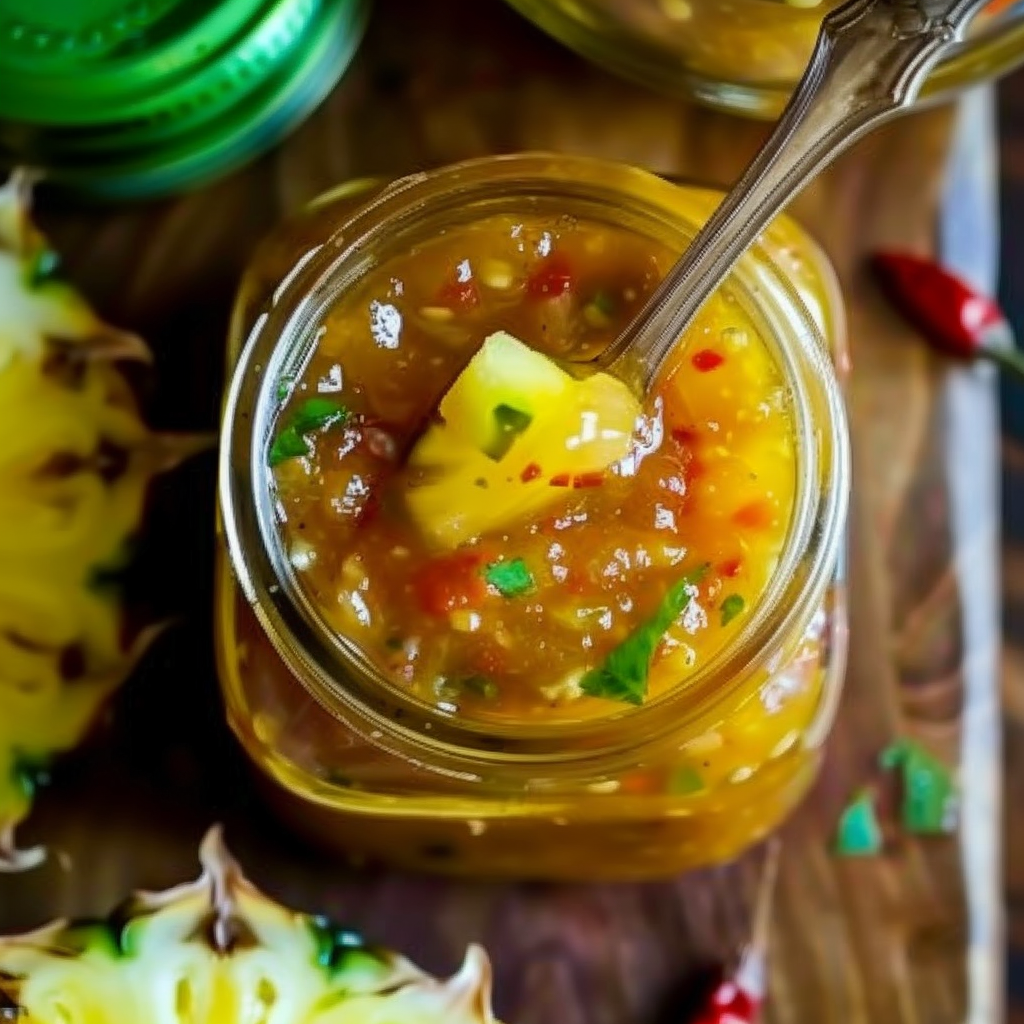
2. What Makes This Sauce Stand Out?
What sets Sweet Chili Pineapple Sauce apart is its perfect fusion of tropical sweetness, mild heat, and savory undertones. It’s not just another dipping sauce—it’s a versatile kitchen essential that elevates everything from appetizers to entrees. The dynamic flavor profile makes it uniquely adaptable for a variety of cuisines, from Asian-inspired dishes to Caribbean favorites.
The crushed pineapple adds more than just sweetness—it introduces a juicy texture and acidity that brighten the overall flavor. This sets it apart from traditional sweet chili sauces, which tend to be more uniform in taste. The combination of vinegar, brown sugar, and soy sauce creates a balance of sour, sweet, and umami, making the sauce incredibly satisfying on the palate. As noted in the Vinegar and Soy Sauce Wikipedia pages, these ingredients are commonly used to enhance depth and complexity in condiments.
If you’re experimenting with new flavors or want to add a twist to your usual dishes, this sauce is a go-to. Pinterest boards like Homemade Dipping Sauces offer inspiration for pairing ideas—from crispy egg rolls and coconut shrimp to roasted cauliflower and sticky meatballs. It’s also a fantastic pineapple sweet sauce for grilled skewers, making it a hit at cookouts and family dinners.
Even better, the ingredients are pantry-friendly, and the sauce comes together in under 15 minutes. It’s a crowd-pleaser that offers gourmet flavor without requiring culinary expertise—ideal for home cooks who want maximum impact with minimal effort.
3. Ingredients Breakdown & Substitutions
Creating Sweet Chili Pineapple Sauce at home is not only simple, but it also allows for customization based on what you have available. Each ingredient in this recipe contributes to its signature balance of flavor and texture. Here’s a detailed breakdown of the ingredients and smart substitutions you can make to suit your taste or dietary needs.
3.1. Crushed Pineapple (fresh vs canned)
-
Fresh pineapple delivers a vibrant, zesty flavor and chunkier texture.
-
Canned pineapple (in juice, not syrup) is more convenient and consistent.
-
For best results, choose pineapple packed in its own juice—this avoids excess sugar and preserves the natural flavor.
-
Fresh pineapple contains bromelain, a natural meat tenderizer (Wikipedia).
Substitution Tip: Use pineapple puree or pineapple juice concentrate if crushed is unavailable, adjusting liquid ratios to maintain sauce consistency.
3.2. Sweet Chili Sauce (store-bought vs homemade)
-
Store-bought versions save time, but be mindful of added preservatives and sugars.
-
Homemade sweet chili sauce gives you control over heat and sweetness levels.
-
A good store-bought option contains garlic, red chili, sugar, and vinegar—avoid those with artificial thickeners.
Related: Learn more about its components on Wikipedia’s sweet chili sauce page.
3.3. Vinegar (Rice vinegar vs Apple cider vinegar)
-
Rice vinegar has a mild, mellow flavor that pairs well with Asian dishes.
-
Apple cider vinegar brings a fruitier tang and works well for a bolder sauce.
Substitution Tip: White vinegar or lemon juice can be used, but they may result in a sharper, less-rounded flavor. See more on types of vinegar here.
3.4. Brown Sugar
-
Adds molasses richness that complements the pineapple and chili.
-
Balances the acidity of vinegar and fruit, rounding out the flavor.
Alternative Sweeteners:
-
Honey: Lends a floral note and smooth finish.
-
Maple syrup: Adds complexity and a slight smokiness.
-
Coconut sugar: Offers a deeper caramel flavor.
Pinterest boards like Fruit-Based Marinades show how varied sugars can influence flavor.
3.5. Soy Sauce
-
Adds depth, saltiness, and umami.
-
Use low-sodium soy sauce to reduce salt without losing flavor.
Substitution Tip: Try coconut aminos for a gluten-free or soy-free alternative—ideal for paleo diets. More on soy sauce’s culinary use can be found here.
3.6. Garlic Powder & Red Pepper Flakes
-
Garlic powder offers subtle aroma without overpowering.
-
Red pepper flakes are optional but add pleasant heat for those who prefer a kick.
Fresh garlic can replace powder for a more pungent, aromatic finish. You can also use chili paste or fresh minced chili for more heat and texture.
Explore similar seasoning tips on Pinterest’s Asian-Inspired Glazes.
3.7. Cornstarch Slurry
-
Thickens the sauce, giving it the desired glaze consistency.
-
Made by mixing equal parts cornstarch and cold water.
Alternatives:
-
Arrowroot powder: Gluten-free and produces a clear finish.
-
Tapioca starch: Adds a glossy sheen.
Check Cornstarch on Wikipedia for its culinary applications and alternatives.
This thoughtful combination of ingredients is what transforms a simple sauce into a standout staple. From sweet to spicy to umami, every component plays a role in building bold flavor while allowing enough flexibility for dietary needs or creative spins.
4. Step-by-Step Instructions
Making Sweet Chili Pineapple Sauce at home is quick and straightforward. With minimal prep and common pantry staples, you’ll have a vibrant, flavorful sauce ready in under 15 minutes. Here’s how to do it the right way, with expert tips to ensure perfect consistency and flavor every time.
Ingredients Recap:
-
1 cup crushed pineapple (with juice)
-
1/2 cup sweet chili sauce
-
2 tablespoons rice vinegar or apple cider vinegar
-
2 tablespoons brown sugar
-
1 tablespoon soy sauce
-
1/2 teaspoon garlic powder
-
1/4 teaspoon red pepper flakes (optional)
-
1 tablespoon cornstarch
-
2 tablespoons water
Instructions:
-
Combine Base Ingredients in a Saucepan
Add the crushed pineapple (with juice), sweet chili sauce, vinegar, brown sugar, soy sauce, garlic powder, and red pepper flakes (if using) to a medium saucepan. Stir everything together until well combined. -
Bring to a Simmer
Place the saucepan over medium heat. Stir occasionally and let the mixture come to a gentle simmer. This allows the flavors to meld and intensifies the sweetness of the pineapple. Don’t let it boil rapidly, as that could burn the sugar content. -
Make the Cornstarch Slurry
In a small bowl, whisk together 1 tablespoon of cornstarch with 2 tablespoons of cold water. This mixture will act as your thickening agent. It’s important to fully dissolve the cornstarch to avoid clumping in the sauce. -
Thicken the Sauce
Slowly pour the slurry into the simmering sauce while stirring continuously. You’ll notice the sauce begin to thicken within a minute. Keep stirring gently for 2–3 more minutes until it reaches a glossy, syrup-like consistency. -
Cool and Store
Remove the pan from heat and let the sauce cool slightly. It will continue to thicken as it cools. Pour it into a clean, airtight jar or container. Refrigerate for up to one week.
Pro Cooking Tips:
-
Adjust the Heat: If you like it spicier, add extra red pepper flakes or a dash of hot sauce. Want it milder? Omit the flakes entirely.
-
Blend for Smoothness: For a smoother texture, blend the finished sauce with an immersion blender or standard blender.
-
Taste and Tweak: After simmering but before thickening, taste your sauce. If it’s too sweet, add a splash more vinegar. If too tangy, a bit more sugar balances it out.
You can explore different thicknesses by adjusting the amount of cornstarch slurry. If you’re going for a pourable glaze, go lighter. For dipping, a slightly thicker consistency is ideal.
Pinterest’s Homemade Dipping Sauces section offers visuals on how sauces like this should look and feel—glossy, rich, and clingy enough to coat food without dripping off. Following these steps ensures your sauce turns out just as good, if not better, than store-bought options.
5. Pro Tips for Flavor & Texture
Mastering the flavor and texture of Sweet Chili Pineapple Sauce comes down to a few strategic tweaks during preparation. These tips will help you achieve a sauce that’s perfectly balanced, silky in texture, and tailored to your palate. Whether you’re serving it as a dip, glaze, or marinade, these techniques will elevate your results from good to unforgettable.
Enhance Flavor Depth
-
Roast the Pineapple: For a deeper, caramelized flavor, roast fresh pineapple chunks in the oven at 400°F for 10–15 minutes before adding to your sauce. This intensifies the natural sugars and adds a light smokiness.
-
Add Fresh Ginger: A teaspoon of finely grated ginger brings a sharp, aromatic note that balances the sweetness and heat. It’s a common addition in many Asian sauces and pairs well with both pineapple and chili pepper (Wikipedia).
-
Use Garlic Paste Instead of Powder: Garlic paste offers a smoother consistency and more vibrant flavor. While garlic powder is convenient, paste or minced garlic adds more depth.
Optimize Texture
-
Control Chunkiness: If you prefer a smoother sauce, blend it after cooking. A quick blitz with an immersion blender breaks down the pineapple while maintaining a rich, thick texture.
-
Adjust Thickness: For a dip, keep the sauce slightly thicker by increasing cornstarch by half a teaspoon. For a glaze or marinade, use less slurry for a thinner finish that spreads more easily.
-
Cool Before Storing: Let the sauce cool fully before transferring to containers. This prevents condensation from watering down the sauce, which is crucial for maintaining its desired consistency.
Pinterest’s Asian-Inspired Glazes offer visual inspiration on how texture impacts presentation, especially when brushed onto meats or drizzled over rice dishes.
By incorporating these pro-level strategies, you’ll unlock the full potential of your homemade pineapple sweet sauce. Little changes—like roasting fruit or adjusting your thickening agent—can have a major impact on how your sauce looks, tastes, and feels on the plate.
6. How to Use Sweet Chili Pineapple Sauce
One of the best things about Sweet Chili Pineapple Sauce is its versatility. This sweet, spicy, and tangy sauce is a multitasker that works across dishes, cuisines, and occasions. Whether you’re using it as a dip, a glaze, or a marinade, its tropical flavor can instantly upgrade your meals.
As a Dip
-
Serve as a dipping sauce for spring rolls, chicken tenders, or vegetable platters.
-
Try pairing it with crispy tofu bites, potstickers, or coconut shrimp for a bold contrast of textures.
-
Pinterest boards like Homemade Dipping Sauces show creative presentation ideas for party trays and appetizer spreads.
As a Glaze
-
Brush onto grilled meats like chicken wings, pork chops, or ribs in the final minutes of cooking for a glossy, caramelized finish.
-
Works wonderfully on salmon or grilled shrimp, adding a tropical twist to seafood dishes.
-
Ideal for BBQs and oven roasting when you’re looking to infuse heat with sweetness.
As a Marinade
-
The natural enzymes in pineapple make this sauce ideal for marinating chicken, pork, or even tofu.
-
Marinate meat for 30 minutes to 2 hours to allow the flavors and tenderizing action to work.
-
A great addition to grilled kebabs or skewers.
As a Topping
-
Drizzle over rice bowls, stir-fries, or even pizza to add a pop of flavor.
-
Use as a sandwich spread alternative for spicy-sweet sandwiches.
-
Try it on breakfast foods like savory waffles or egg wraps for a fusion twist.
For additional tropical inspiration, browse the Pineapple Sauce Recipes board, which includes similar sauces used in tacos, noodles, and fusion dishes.
With just one batch, you’ll find countless ways to enjoy this flavorful pineapple chili sauce—and you’ll likely never go back to store-bought again.
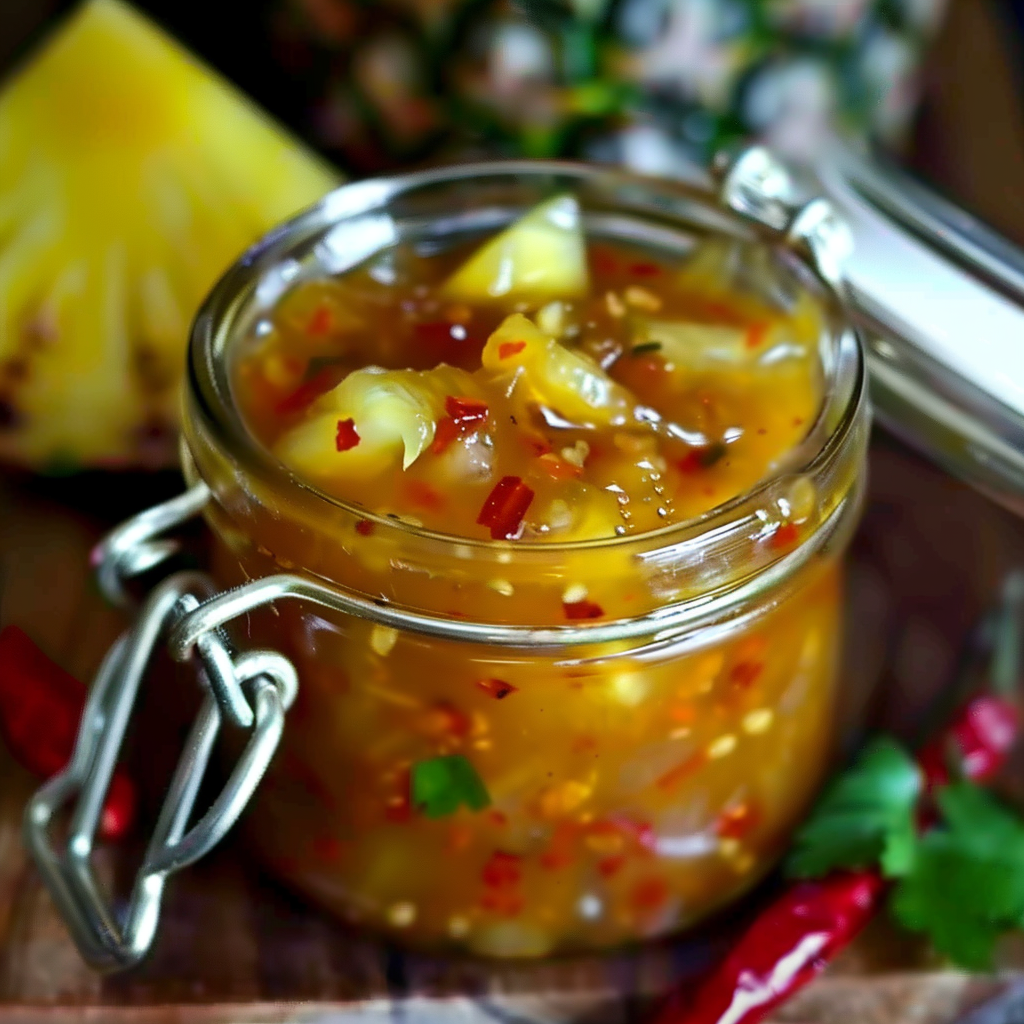
7. Fresh vs Canned Pineapple: Which to Use?
When choosing between fresh and canned pineapple for this sauce, both options offer their own advantages, depending on your priorities in flavor, texture, and convenience.
Fresh Pineapple
-
Offers the brightest, most vibrant flavor.
-
Has a firmer texture that holds up better if you want chunkier sauce.
-
Contains bromelain, an enzyme that can help tenderize meat (Wikipedia).
Canned Pineapple
-
More convenient and shelf-stable.
-
Easier to use, especially when already crushed or packed in juice.
-
More consistent in sweetness and texture.
Best Choice: If you’re short on time or want a smoother finish, use canned crushed pineapple in juice. For a fresher, more pronounced fruit flavor, go with fresh pineapple and blend to the texture you prefer.
8. Sugar Choices: Brown Sugar vs Alternatives
The type of sugar you use in your Sweet Chili Pineapple Sauce greatly impacts its final flavor and depth. While brown sugar is the default choice, there are several alternatives worth considering.
Brown Sugar
-
Rich in molasses flavor.
-
Helps achieve a slightly caramelized finish during cooking.
-
Balances the heat and acidity of the other ingredients.
Alternatives
-
Honey: Adds floral sweetness and smooth mouthfeel.
-
Maple Syrup: Brings a deep, woodsy sweetness and blends well with chili.
-
Coconut Sugar: Lower glycemic index and subtle caramel notes.
-
White Sugar: Neutral sweetness but lacks depth.
Pinterest’s Fruit-Based Marinades show how different sweeteners pair with tropical fruits and spicy elements. Adjust the amount slightly based on the sugar type used—liquid sweeteners may require reducing other liquids in the recipe.
Choosing your sweetener lets you control the sauce’s flavor intensity, health profile, and even texture.
9. How to Store and Preserve the Sauce
Proper storage is essential to maintain the flavor, texture, and safety of your homemade sweet chili pineapple sauce. Since it contains fresh fruit and no preservatives, it has a shorter shelf life than commercial sauces.
Refrigeration
-
Store in an airtight glass jar or container.
-
Keeps fresh in the fridge for up to 1 week.
-
Stir before using, as separation is natural.
Freezing
-
Pour into ice cube trays for individual servings.
-
Once frozen, transfer cubes to a freezer bag.
-
Keeps for up to 2 months with minimal flavor loss.
Canning (Advanced)
-
If you want to make it shelf-stable, follow proper water bath canning procedures.
-
Use sterilized jars and maintain food-safe pH levels.
-
Requires careful handling of sugar and acid ratios.
Refer to Vinegar and Cornstarch guidelines for safety and thickening tips when preserving sauces.
Whichever method you choose, always label the container with the date and contents to avoid confusion or spoilage.
10. Variations to Try
Looking to tweak your pineapple sweet chili sauce into something new? These creative variations allow you to experiment with flavors, ingredients, and heat levels to suit your tastes or dietary goals.
Mango Sweet Chili Sauce
-
Swap pineapple with mango or do a 50/50 mix.
-
Mango adds tropical richness and a creamy texture.
-
Ideal for seafood or grilled chicken.
Sweet Chili Pineapple Habanero
-
Add minced habanero pepper for intense heat.
-
Balances with sweetness for hot sauce lovers.
-
Use sparingly in glazes or dipping sauces.
Sugar-Free or Keto-Friendly
-
Replace brown sugar with erythritol or monk fruit sweetener.
-
Make sure to use a keto-approved sweet chili sauce base.
-
Great for low-carb diets.
Add-ins and Boosters
-
Ginger: Adds sharp, aromatic complexity.
-
Lime juice: Brightens the sauce with citrus acidity.
-
Fresh herbs (like cilantro or mint): Add a layer of freshness.
Explore more fun combinations and creative pairings on Asian-Inspired Glazes, where sauces are adapted for a variety of fusion dishes and flavor profiles.
11. Common Mistakes to Avoid
Even with a simple recipe like this, a few missteps can affect your sauce’s quality. Avoid these common mistakes to ensure a flawless finish every time.
-
Over-thickening: Adding too much cornstarch can make the sauce gummy or gel-like. Stick to the measured slurry.
-
Burning the sugar: Use medium heat and stir regularly—sugar burns fast and ruins the flavor.
-
Imbalanced flavors: Taste before thickening. Adjust sugar, vinegar, or soy sauce as needed.
-
Using syrup-packed pineapple: It makes the sauce overly sweet and masks the natural fruitiness.
-
Skipping the simmer: Simmering helps blend the flavors and dissolve sugars for a cohesive sauce.
For more cooking tips, check out Homemade Dipping Sauces on Pinterest for visuals and advice from food bloggers.
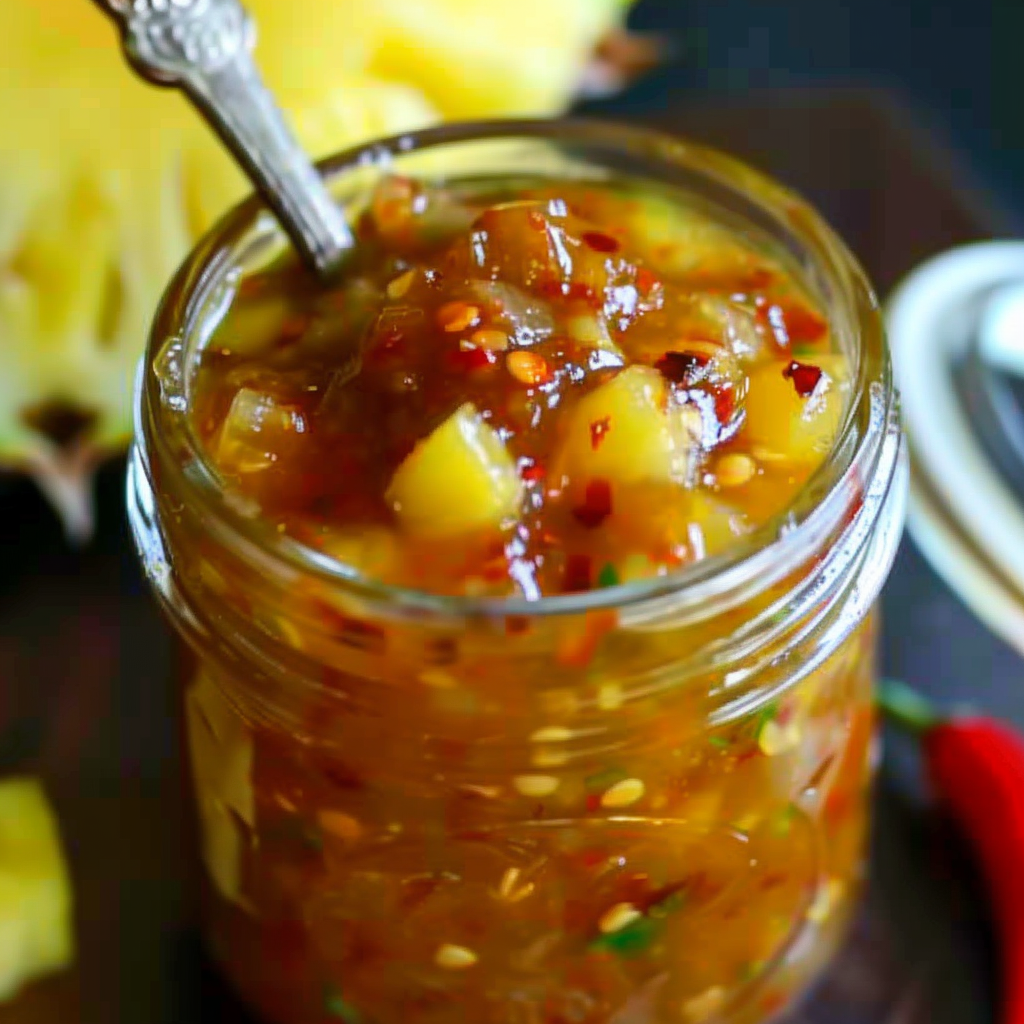
12. FAQs – People Also Ask
Is sweet chili pineapple sauce spicy?
It’s mildly spicy. The base sweet chili sauce adds gentle heat, while red pepper flakes can increase the spice. Omit them for a sweeter profile.
Can I make it sugar-free or keto-friendly?
Yes, use sugar substitutes like monk fruit, erythritol, or stevia. Also, check the sweet chili sauce you use for added sugars.
How long does homemade chili sauce last in the fridge?
Stored in an airtight container, it lasts up to 1 week. For longer storage, freeze in portions.
Can I use this sauce for grilling?
Absolutely. Brush it on meats or veggies during the last few minutes of grilling for a glossy glaze with a flavor boost.
What can I use instead of cornstarch?
Arrowroot powder and tapioca starch are excellent alternatives. These are also gluten-free and create a glossy finish.
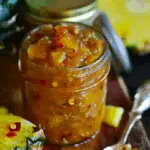
Sweet Chili Pineapple Sauce The Ultimate Homemade Sweet Chili Sauce Guide
- Author: Naomi
Description
This Sweet Chili Pineapple Sauce is the ultimate tropical condiment—sweet, spicy, and tangy with the bright, fruity flavor of pineapple and the gentle heat of sweet chili. Perfect as a dip for spring rolls, a glaze for chicken or shrimp, or a marinade for meats and tofu, this quick and easy recipe brings big flavor with minimal effort. It’s naturally gluten-free, customizable in sweetness and spice, and ready in under 15 minutes.
Ingredients
- 1 cup crushed pineapple (with juice)
- 1/2 cup sweet chili sauce
- 2 tablespoons rice vinegar or apple cider vinegar
- 2 tablespoons brown sugar
- 1 tablespoon soy sauce
- 1/2 teaspoon garlic powder
- 1/4 teaspoon red pepper flakes (optional, for heat)
- 1 tablespoon cornstarch
- 2 tablespoons water
Instructions
In a small saucepan, combine crushed pineapple with juice, sweet chili sauce, vinegar, brown sugar, soy sauce, garlic powder, and red pepper flakes if using.
Bring the mixture to a simmer over medium heat, stirring occasionally.
In a small bowl, mix cornstarch and water until smooth.
Slowly pour the cornstarch slurry into the saucepan while stirring.
Continue cooking and stirring until the sauce thickens, about 2–3 minutes.
Remove from heat and let it cool slightly before serving or storing.
Use as a dipping sauce, glaze, or topping for chicken, shrimp, rice, or vegetables. Store in an airtight container in the fridge for up to 1 week.
Notes
-
Fresh vs Canned Pineapple: Use fresh for brighter flavor and texture; canned for convenience.
-
Sugar Options: Brown sugar adds depth, but honey or maple syrup can be used for variation.
-
Spice Level: Red pepper flakes are optional—adjust based on your heat preference.
-
Storage: Keeps in the fridge for 1 week or can be frozen in small batches.
-
Blending Option: Blend for a smoother texture if using in drizzles or sauces.


